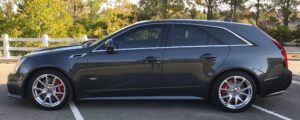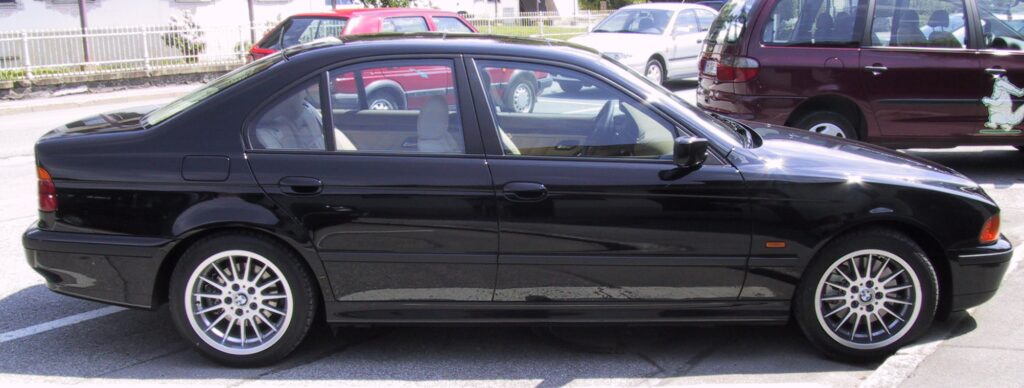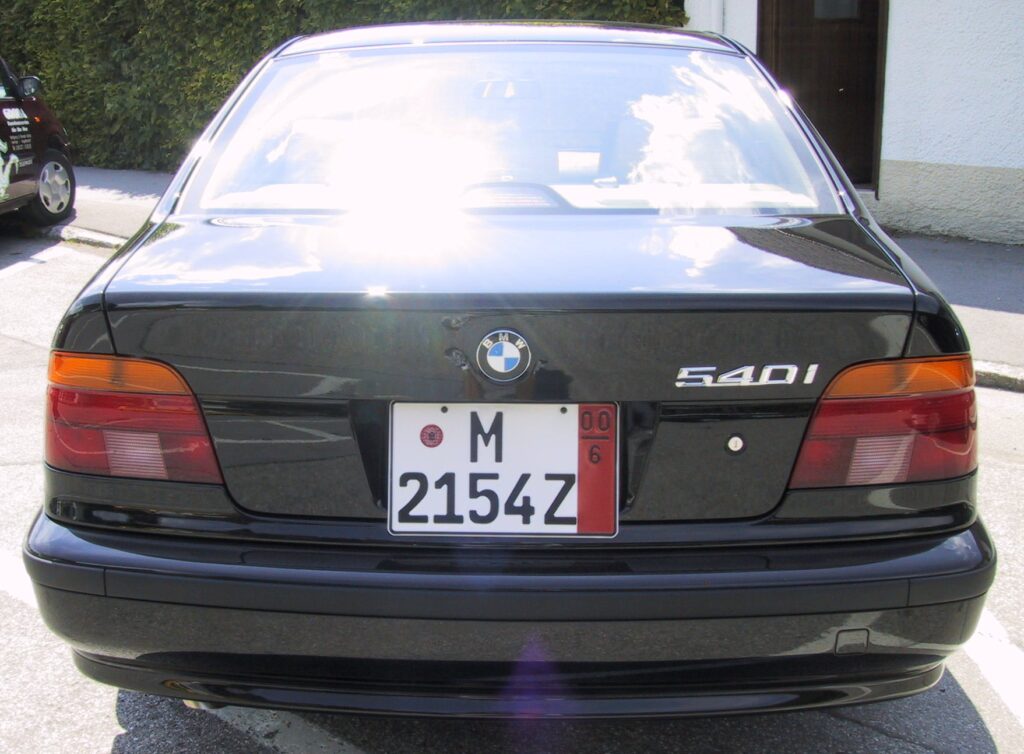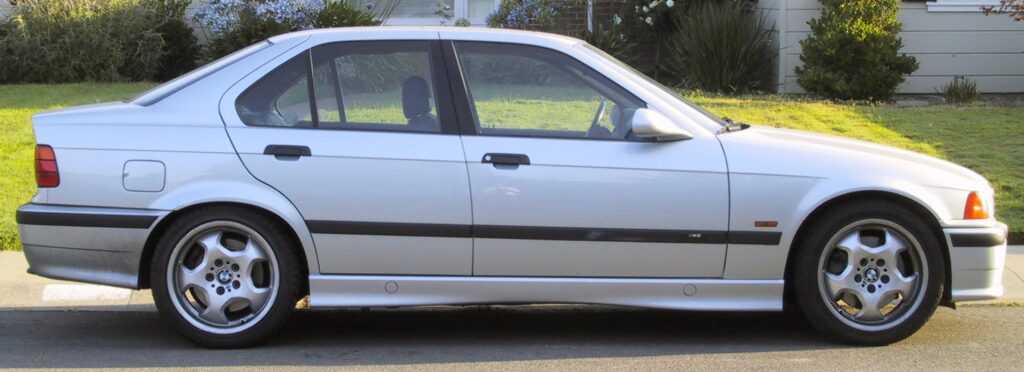My goal is to build a California-legal, LS3-swapped, 1996 Dakar Yellow M3 restomod. The LS M3 will keep its subdued 90s look but be transformed into a reliable, unique, fun, and comfortable daily driver. I get the question from people and my family why a 90s e36 M3? Why a yellow M3? Wait, you’re going to swap a Chevy V8 in it!?
For the last 3 years, I have been searching for a fun, fast, and unique car. I love wagons, so I bought a 2014 Cadillac CTS-V. It’s a great car, unique, rare, and good-looking, but at 4,300 pounds, it’s neither light nor nimble. I then purchased an F56 JCW Mini, a light, quick car with a unique look. I loved my past R56 Mini Cooper S, raw and analog. The F56 is quick, light but doesn’t feel raw. It’s too buttoned-up and has all the nanny safeties.

My 2014 Cadillac CTS-V
I was surfing Bring a Trailer listings and saw an auction for an e36 M3. It brought back memories of a 97 M3 sedan I owned between 1997 and 2000. The car was compact, light, fun, comfortable, and I loved the subdued but elegant styling. My lease was about to end, and I test drove the BMW e39 540 sport. I immediately recognized what was missing – the sound and torque of a V-8. I quickly put my order in for a 540 sport and picked it up in Germany. I liked the torque so much I reduced my first set of rear tires to slicks in 6,000 miles.

My e39 540 Sport 
German Plates on my 540 
My 1997 M3 Sedan
It’s been 21 years since my last e36 M3 sedan, and now I’m thinking about the exact specification I want in my next one. My ideal e36 M3 is a coupe with Vader seats, the factory wing/spoiler, and either the DS2, Double-Spoke Type II, Sunflowers (style 39) or M Contours, Soccer Balls (style 23) wheels. My two favorite exterior colors are the Estoril Blue or Dakar Yellow with black Napa leather interior.
This is not just an engine swap but a true restomod. The car needs to retain the original look and analog feel, but with the modern items we want in a luxury sports sedan from 2021. That means Apple CarPlay, back up camera, heated seats, air conditioning. The suspension needs to be tight and compliant, just like when it was new. M3 interiors were considered nice back in the day, and I like the Vader seats. Still, I will need to make some enhancements like updating the instrument cluster’s look with metal rings, adding a steering wheel with a flat bottom covered in Alcantara. Including using Alcantara for the shift boot, parking brake boot, and shift knob.
Everything needs to work and function as well as when new or better. The key to this restomod is the engine swap. The car must be completely CARB approved to be registered and driven in California. I get excited dreaming about an M3 with a V8 generating 426 horsepower and 423 pounds of torque plus the sound of that exhaust. I want to retain stock e36 M3 rims, but the extra power will most likely require larger wheels. My favorite BMW M wheels are the Style 37 Parallels, but the biggest factor is fit without too much fender modification.
The idea firmly in my head, I started doing the homework to see if this was even possible. Quickly it became apparent that many people have done LS swaps in e36 BMW. There are companies, Vorschlag, Sikky, JTR, and others, selling complete kits for both LS1 or LS3, including headers, motor mounts, steering shaft, and wiring kits. The one thing that was missing was California-legal, CARB-certified LS swap in an e36.
I emailed the Vorschlag team, and they were kind enough to respond, saying there are no CARB-legal kits due to the steering shaft clearance and the stock exhaust manifolds. The LS kits are a thinner steering shaft and custom headers to help with the clearance issues. In California, the rules say you must use an engine that is the same year or newer, and all the smog equipment from the donor car must be installed in the car receiving the donor engine. Also, all equipment must be installed and demonstrated to be working via the OBD 2 monitor and visual inspection. This means aftermarket headers without a CARB EO number will fail the visual inspection. This was a punch to the gut, but I had seen e36 M3s’ with California license plate and LS swaps on the internet.
I kept digging and reading through BMW forums and LSX when I discovered a couple of people had CARB-legal LS swaps. In one entry, a forum member posted pictures of the two challenges I mentioned above, steering shaft clearance while using stock LS1 exhaust manifolds from a 2002 Camaro Z28. The forum member posted the pictures and how he made it all work.
He had to do quite a bit. First, moving the steering column over very slightly. Second, creating a multi-joint steering shaft, and third, needed to mill the exhaust manifold by a small amount. Once he buttoned it up, he was able to go to the BAR referee to get tested, and after a couple of tries, was awarded his CARB EO-approved sticker for the engine swap. This gave me the confidence to start talking and looking for shops specializing in BMWs or LS Swaps.
Many shops advertised doing LS swaps, but most said 1975 or older cars. Cars that do not need to be inspected by the California Bureau of Automotive Repair (BAR). I spoke with some that were familiar with doing LS swaps in newer cars but not BMW’s. After some more hunting on the internet, I noticed a couple of names associated with BMW’s and LS Swaps.
I reached out to three garages, and each one was helpful about what was possible, including explaining to me everything that would need to be changed on an LS engine swap for an e36 M3. I started putting together a spreadsheet to budget the items needed for the swap and then researching how to pick a builder or garage. The conversations spurred me to talk to a BAR referee.
In my 40-minute conversation with the BAR referee, they told me all engine swaps require BAR referee inspection in vehicles built after 1975. I asked their opinion on using an engine out of a donor 2010-2015 SS Camaro. They said that was possible but using a GM EROD crate engine would allow me an easier time passing BAR since everything is included in the kit, and there is less guesswork. I must admit he made the inspection process sound extremely subjective to who was inspecting the car. This is not exactly comforting, but if you follow the guidelines, the car will pass. It might just take a couple of attempts.
After researching making it California-legal and getting a rough cost to build a car, I decided to find a car and choose a builder. And so our story begins.
